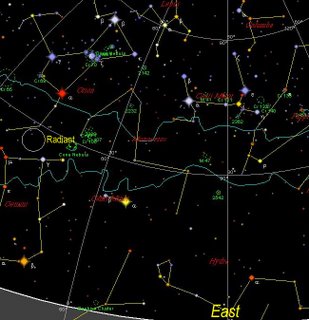Tuesday, October 17, 2006
Orionids on Saturday and Sunday (21-22 Oct)
 The morning sky as seen in the Southern Hemisphere, facing northeast at 2.00 am.
The morning sky as seen in the Southern Hemisphere, facing northeast at 2.00 am.The Orionids are a fairly reliable meteor shower that somewhat favours the Southern Hemisphere. This year the moon is new during the maximum, so we have a good chance to see some decent Orionids for the first time in ages.
The Orionids peak in the early UT morning of the 21st, for Australians, this means the peak is in the middle of the day on 21st, and the best time to observe is early morning on Sunday the 22nd. However as the Orionid peak is broad, watching on the early morning of Saturday 21 will work too.
The radiant, the point where meteors appear to originate from, is just below Betelgeuse, alpha Orionis, below the distinctive saucepan shape of Orions Belt.
Although Orion rises before midnight, you will need to wait until around 2 am before the radiant is high enough to see significant meteor action. The ZHR for this years Orionids is 23, but for most of the night you could expect to see around one meteor every 5 minutes. The Orionids aren't particularly bright (which is a pain in the inner suburbs), but every so often you should see a nice one.
When watching, rug up well (it will get cold), and get yourself a comfy chair or banana lounge and scan the sky around the radiant. Although the meteors seem to originate there, when traced back, you will usually pick them up some distance away, so sweep around the area to pick up meteors. Give yourself a little while for your eyes to accommodate, the first five minutes or so in the dark will be wasted as your eyes dark adapt.
While watching for Orionids, keep an eye out for Satellites, if you are watching in the Central states, from about Alice Springs down, on the 21st at around 4:44 am the ISS passes under Saturn. Should be nice.
Comments:
<< Home
Thanks for the data Ian. If you don't mind I will link my blog to you as some of my visitors actually have minds.
Post a Comment
<< Home




 Click to read about or order
Click to read about or order Click to read about or order
Click to read about or order Click to read about or order
Click to read about or order Click to read about or order
Click to read about or order




